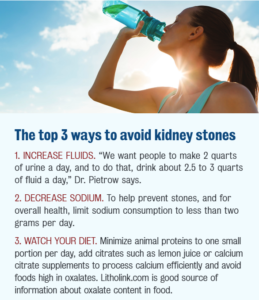Sometimes kidney stones can be avoided, but several minimally invasive procedures are highly effective if they occur.
Anyone who has ever had a kidney stone knows how awful it is,” says Dr. Paul K. Pietrow, a urologist with
Premier Medical Group. “Many women say they’d rather experience the pain of childbirth than pass a stone.”
Kidney stones are hard masses of material, usually calcium oxalate, that form in the urine. They may be as  small as a grain of sand or as large as a marble. Most kidney stones pass out of the body naturally. Sometimes, however, a stone may get stuck in the urinary tract, blocking urine and causing tremendous pain.
small as a grain of sand or as large as a marble. Most kidney stones pass out of the body naturally. Sometimes, however, a stone may get stuck in the urinary tract, blocking urine and causing tremendous pain.
The prevalence of kidney stones is rising in the U.S., Dr. Pietrow says. “That is probably because of the Western diet and weight gain; studies show that being overweight or obese raises stone risk.” Women are also experiencing kidney stones in increasing numbers. “The male-to-female ratio used to be 3:1, but now it is closer to 2:1 or even less,” he says.
For patients who experience repeat stone episodes or present unusual health histories, Premier’s urologists order a metabolic profile to discover the biochemistry that may be causing stone formation. “With a more precise diagnosis, we can get more precise prevention strategies,” he says. These may include medications that are directed at metabolic abnormalities. For example, the thiazide family of diuretic medications helps control calcium excretion; potassium citrates alkalinize the urine; allopurinol decreases uric acid production. “Medications can drop stone events by 90 percent,” Dr. Pietrow says. But less than 50 percent of patients are prescribed meds. “Most patients control stones through fluid intake and dietary changes. Weight management and other lifestyle modifications can have a significant impact; increasing fluids can drop the risk by 50 percent all by itself,” Pietrow says.
MINIMALLY INVASIVE STONE REMOVAL
There are three currently used techniques for removing stones. Open surgery, which was widely employed in past decades, “is now almost completely historical,” Dr. Pietrow says. “I have never done it or seen it done.”
The first approach, perhaps the most commonly known, is extracorporeal shock wave lithotripsy (ESWL). Sound waves are focused onto the stone to break it into smaller pieces that can more easily be passed. ESWL is effective up to about 70 percent of the time, working best on stones in certain areas of the kidney and urinary tract, and is not as effective on larger, denser stones. “When it was developed, 30 years ago, it was truly groundbreaking, but the field of urology is now considering, in light of other procedures available, how large a role it should play,” says Pietrow.
The second option, ureteroscopy, has become the workhorse of stone removal. Thanks to the development of thin, flexible, fiberoptic endoscopes, urologists are able to send a camera and laser through the ureter and, as Dr. Pietrow says, “check every nook and cranny of the plumbing.” The laser breaks down the stone and the surgeon can then extract it or allow the smaller pieces to pass naturally. “Because we can look at the stone, we can see whether we are done or not,” he says. “That’s why it has a much higher success rate than ESWL—above 90 percent.”
Percutaneous nephrolithotomy (PCNL), the third option, is usually reserved for large stones (over 2cm, the size of a marble) and cases in which the other options are not feasible. A small incision is made in the patient’s back through which a needle, a tube and several small instruments are positioned in the kidney. The stone is broken up with ultrasonic waves and the pieces removed through the tube. Though it is somewhat more invasive than the other methods, it is highly effective and, in some cases, the only option.
Your urologist will take all the particulars of your case into account and help you understand which is your preferred stone removal option.
